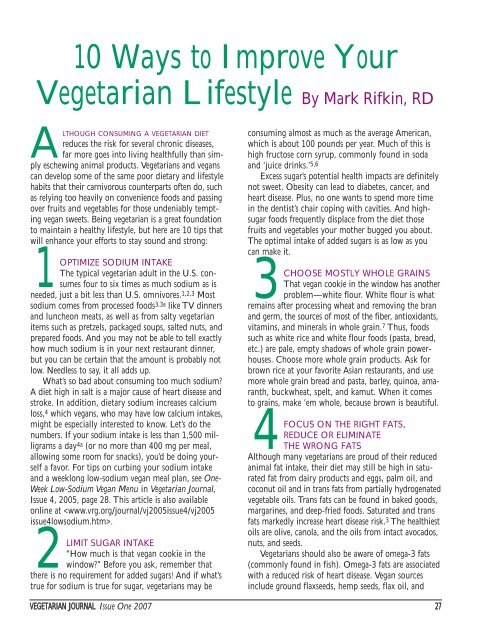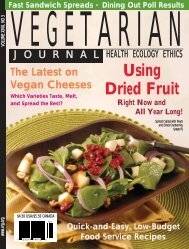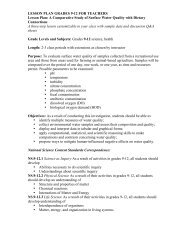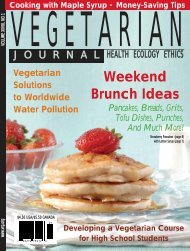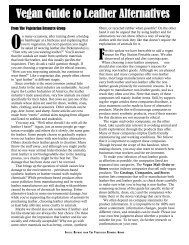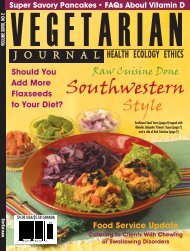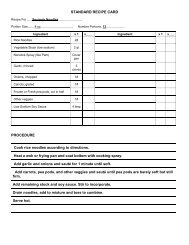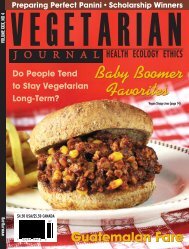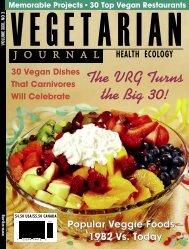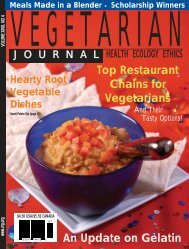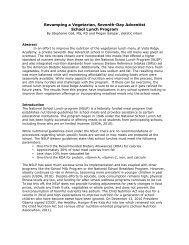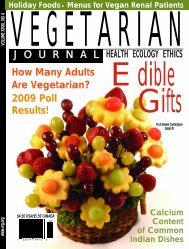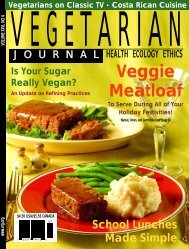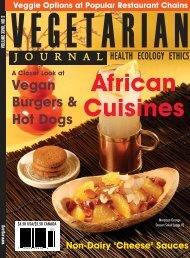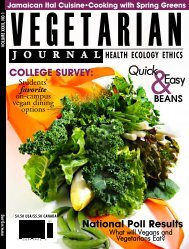Vegan Thickeners - The Vegetarian Resource Group
Vegan Thickeners - The Vegetarian Resource Group
Vegan Thickeners - The Vegetarian Resource Group
Create successful ePaper yourself
Turn your PDF publications into a flip-book with our unique Google optimized e-Paper software.
10 Ways to Improve Your<br />
<strong>Vegetarian</strong> Lifestyle By Mark Rifkin, RD<br />
ALTHOUGH CONSUMING A VEGETARIAN DIET<br />
reduces the risk for several chronic diseases,<br />
far more goes into living healthfully than simply<br />
eschewing animal products. <strong>Vegetarian</strong>s and vegans<br />
can develop some of the same poor dietary and lifestyle<br />
habits that their carnivorous counterparts often do, such<br />
as relying too heavily on convenience foods and passing<br />
over fruits and vegetables for those undeniably tempting<br />
vegan sweets. Being vegetarian is a great foundation<br />
to maintain a healthy lifestyle, but here are 10 tips that<br />
will enhance your efforts to stay sound and strong:<br />
1OPTIMIZE SODIUM INTAKE<br />
<strong>The</strong> typical vegetarian adult in the U.S. consumes<br />
four to six times as much sodium as is<br />
needed, just a bit less than U.S. omnivores. 1,2,3 Most<br />
sodium comes from processed foods 3,3a like TV dinners<br />
and luncheon meats, as well as from salty vegetarian<br />
items such as pretzels, packaged soups, salted nuts, and<br />
prepared foods. And you may not be able to tell exactly<br />
how much sodium is in your next restaurant dinner,<br />
but you can be certain that the amount is probably not<br />
low. Needless to say, it all adds up.<br />
What’s so bad about consuming too much sodium?<br />
A diet high in salt is a major cause of heart disease and<br />
stroke. In addition, dietary sodium increases calcium<br />
loss, 4 which vegans, who may have low calcium intakes,<br />
might be especially interested to know. Let’s do the<br />
numbers. If your sodium intake is less than 1,500 milligrams<br />
a day 4a (or no more than 400 mg per meal,<br />
allowing some room for snacks), you’d be doing yourself<br />
a favor. For tips on curbing your sodium intake<br />
and a weeklong low-sodium vegan meal plan, see One-<br />
Week Low-Sodium <strong>Vegan</strong> Menu in <strong>Vegetarian</strong> Journal,<br />
Issue 4, 2005, page 28. This article is also available<br />
online at .<br />
2LIMIT SUGAR INTAKE<br />
“How much is that vegan cookie in the<br />
window?” Before you ask, remember that<br />
there is no requirement for added sugars! And if what’s<br />
true for sodium is true for sugar, vegetarians may be<br />
consuming almost as much as the average American,<br />
which is about 100 pounds per year. Much of this is<br />
high fructose corn syrup, commonly found in soda<br />
and ‘juice drinks.’ 5,6<br />
Excess sugar’s potential health impacts are definitely<br />
not sweet. Obesity can lead to diabetes, cancer, and<br />
heart disease. Plus, no one wants to spend more time<br />
in the dentist’s chair coping with cavities. And highsugar<br />
foods frequently displace from the diet those<br />
fruits and vegetables your mother bugged you about.<br />
<strong>The</strong> optimal intake of added sugars is as low as you<br />
can make it.<br />
3CHOOSE MOSTLY WHOLE GRAINS<br />
That vegan cookie in the window has another<br />
problem—white flour. White flour is what<br />
remains after processing wheat and removing the bran<br />
and germ, the sources of most of the fiber, antioxidants,<br />
vitamins, and minerals in whole grain. 7 Thus, foods<br />
such as white rice and white flour foods (pasta, bread,<br />
etc.) are pale, empty shadows of whole grain powerhouses.<br />
Choose more whole grain products. Ask for<br />
brown rice at your favorite Asian restaurants, and use<br />
more whole grain bread and pasta, barley, quinoa, amaranth,<br />
buckwheat, spelt, and kamut. When it comes<br />
to grains, make ’em whole, because brown is beautiful.<br />
4FOCUS ON THE RIGHT FATS,<br />
REDUCE OR ELIMINATE<br />
THE WRONG FATS<br />
Although many vegetarians are proud of their reduced<br />
animal fat intake, their diet may still be high in saturated<br />
fat from dairy products and eggs, palm oil, and<br />
coconut oil and in trans fats from partially hydrogenated<br />
vegetable oils. Trans fats can be found in baked goods,<br />
margarines, and deep-fried foods. Saturated and trans<br />
fats markedly increase heart disease risk. 3 <strong>The</strong> healthiest<br />
oils are olive, canola, and the oils from intact avocados,<br />
nuts, and seeds.<br />
<strong>Vegetarian</strong>s should also be aware of omega-3 fats<br />
(commonly found in fish). Omega-3 fats are associated<br />
with a reduced risk of heart disease. <strong>Vegan</strong> sources<br />
include ground flaxseeds, hemp seeds, flax oil, and<br />
VEGETARIAN JOURNAL Issue One 2007 27


